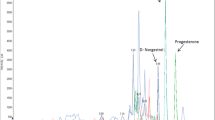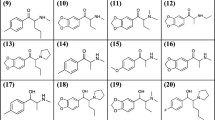Abstract
Transportation of doping control urine samples from the collection sites to the World Anti-doping Agency (WADA) Accredited Laboratories is conducted under ambient temperatures. When sample delivery is not immediate, microbial contamination of urine, especially in summer, is a common phenomenon that may affect sample integrity and may result in misinterpretation of analytical data. Furthermore, the possibility of intentional contamination of sports samples during collection with proteolytic enzymes, masking the abuse of prohibited proteins such as erythropoietin (EPO) and peptide hormones, is a practice that has already been reported. Consequently, stabilization of urine samples with a suitable method in a way that protects samples’ integrity is important. Currently, no stabilization method is applied in the sample collection equipment system in order to prevent degradation of urine compounds. The present work is an overview of a study, funded by WADA, on degradation and stabilization aspects of sports urine samples against the above threats of degradation. Extensive method development resulted in the creation of a mixture of chemical agents for the stabilization of urine. Evaluation of results demonstrated that the stabilization mixture could stabilize endogenous steroids, recombinant EPO, and human chorionic gonadotropin in almost the entire range of the experimental conditions tested.





Similar content being viewed by others
Notes
β-subunit of hCG, according to the nomenclature proposed by the International Federation of Clinical Chemistry and Laboratory Medicine (IFCC) [43].
References
Rushall BS, Jones M (2006) The anti-drugs-in-sport movement: causes for concern. International Journal of Sports Science and Coaching 1(1):1–18
Kuenen JG, Konings WN (2010) The importance of cooling of urine samples for doping analysis. Accredit Qual Assur 15:133–136
Geyer H, Schänzer W, Mareck-Engelke U, Donike M (1995) Factors influencing the steroid profile. In: Schänzer W, Geyer H, Gotzmann A, Mareck-Engelke U (eds) Recent advances in doping analysis (3). Sportverlag Strauß, Köln, pp 95–113
Hemmersbach P, Birkeland KI, Norli HR, Ringertz SH (1997) Urine storage conditions and steroid profile analysis. In: Schänzer W, Geyer H, Gotzmann A, Mareck-Engelke U (eds) Recent advances in doping analysis (4). Sportverlag Strauß, Köln, pp 99–106
Ayotte C, Charlebois A, Lapointe S, Barriault D, Sylvestre M (1997) Validity of urine samples: microbial degradation. In: Schänzer W, Geyer H, Gotzmann A, Mareck-Engelke U (eds) Recent advances in doping analysis (4). Sportverlag Strauß, Köln, pp 127–137
Ayotte C, Charlebois A, Lapointe S, Sylvestre M, Barriault D (1997) Microbial degradation of urine samples collected in Athletic Drug testing programmes. Report submitted to the International Athletic Foundation, IAF Project, pp 93–96
de la Torre R, de la Torre X, Alia C, Segura J, Baro T, Torres-Rodriguez JM (2001) Changes in androgenic steroid profile due to urine contamination by microorganisms: a prospective study. Anal Biochem 289:116–122
Kicman AT, Fallon JK, Cowan DA, Walker C, Easmon S, Mackintosh D (2002) Candida albicans in urine can produce testosterone: impact on the testosterone/epitestosterone sports drug test. Clin Chem 48:1799–1801
Kwiatkowska D, Pokrywka A, Jaźwiec R, Turek-Lepa E, Starościak B, Lewandowska-Pachecka S, Pachecka J, Grucza R (2005) The research of microbiological stability in anti-doping samples. In: Schänzer W, Geyer H, Gotzmann A, Mareck U (eds) Recent Advances in Doping Analysis (13). Sportverlag Strauß, Köln, pp 453–456
Tsivou M, Livadara D, Georgakopoulos DG, Koupparis M, Atta-Politou J, Georgakopoulos CG (2009) Stabilization of human urine doping control samples. Anal Biochem 388(2):179–191
Ayotte C, Goudreault D, Charlebois A (1996) Testing for natural and synthetic anabolic agents in human urine. J Chromatogr B 687:3–25
van de Kerkhof DH, de Boer D, Thijssen JHH, Maes RAA (2000) Evaluation of Testosterone/Epitestosterone ratio influential factors as determined in doping analysis. J Anal Toxicol 24:102–115
Mareck U, Geyer H, Opfermann G, Thevis M, Schänzer W (2008) Factors influencing the steroid profile in doping control analysis. J Mass Spectrom 43:877–891
WADA (2004) Technical document-TD2004EAAS ver.1.0. Reporting and evaluation guidance for testosterone, epitestosterone, T/E ratio and other endogenous steroids. Available at: http://www.wada-ama.org/rtecontent/document/end_steroids_aug_04.pdf. Accessed 6 December 2010
Ojanperä S, Leinonen A, Apajalahti J, Lauraeus M, Alaja S, Moisander T, Kettunen A (2010) Characterization of microbial contaminants in urine. Drug test. Analysis 2:576–581
Thevis M, Maurer J, Kohler M, Schänzer W (2007) Proteases in doping control analysis. Int J Sports Med 28:545–549
Kohler M, Thomas A, Geyer H, Horta L, Schänzer W, Thevis M (2009) Detection of the protease Bacillolysin in doping-control urine samples. Drug Test Analysis 1:143–145
Thomas A, Kohler M, Walpurgis K, Schänzer W, Thevis M (2009) Proteolysis and autolysis of proteases and the detection of degradation products in doping control. Drug Test Analysis 1:81–86
Horta L (2010) Collaboration between law enforcement and NADOs—the tampering with proteases affair. 9th Annual USADA Symposium on Anti-Doping Science Lansdowne. Virginia, USA
WADA (2010) The World Anti-Doping Code, The 2010 the prohibited list, International standard. Available at: http://www.wada-ama.org/Documents/World_Anti-Doping_Program/WADP-Prohibited-list/WADA_Prohibited_List_2010_EN.pdf. Accessed 6 December 2010
Lasne F, Martin L, de Ceaurriz J (2005) Active urine and detection of recombinant erythropoietin. In: Schänzer W, Geyer H, Gotzmann A, Mareck U (eds) Recent advances in doping analysis (13). Sportverlag Strauß, Köln, pp 297–304
Lamon S, Robinson N, Sottas P-E, Henry H, Kamber M, Mangin P, Saugy M (2007) Possible origin of undetectable EPO in urine samples. Clin Chim Acta 385:61–66
Saudan C, Entenza JM, Baume N, Mangin P, Saugy M (2006) Short-term stability of testosterone and epitestosterone conjugates in urine samples: quantification by liquid chromatography-linear ion trap mass spectrometry. J Chromatogr B 844:168–174
Belalcazar V, Pascual JA, Abanades S, Farré M, de la Torre R (2005) Stability of EPO in urine stabilized by sodium azide. In: Schänzer W, Geyer H, Gotzmann A, Mareck U (eds) Recent advances in doping analysis (13). Sportverlag Strauß, Köln, pp 427–431
Dehnes Y, Borgen M, Hemmersbach P (2007) Enzymatic digestion of EPO. In: Schänzer W, Geyer H, Gotzmann A, Mareck U (eds) Recent advances in doping analysis (15). Sportverlag Strauß, Köln, pp 405–408
Stenman U-H, Hotakainen K, Alfthan H (2008) Gonadotropins in doping: pharmacological basis and detection of illicit use. Br J Pharmacol 154:569–583
Honour JW (1996) Testing for drug abuse. Lancet 348:41–43
WADA (2010) The World Anti-Doping Program, Guidelines for urine sample collection ver. 5.1. Available at: http://www.wada-ama.org/Documents/Resources/Guidelines/WADA_Guidelines_Urine_Sample_Collection_v5.1.pdf. Accessed 6 December 2010
WADA (2010) The World Anti-Doping Program, Guidelines for blood sample collection ver. 2.2. Available at: http://www.wada-ama.org/Documents/Resources/Guidelines/WADA_Guidelines_Blood_Sample_Collection_v2.2.pdf. Accessed 6 December 2010
Evans MJ, Livesey JH, Ellis MJ, Yandle TG (2001) Effect of anticoagulants and storage temperatures on stability of plasma and serum hormones. Clin Biochem 34(2):107–112
Ellis MJ, Livesey JH, Evans MJ (2003) Hormone stability in human whole blood. Clin Biochem 36(2):109–112
Renehan AG, Jones J, O'Dwyer ST, Shalet SM (2003) Determination of IGF-I, IGF-II, IGFBP-2, and IGFBP-3 levels in serum and plasma: comparisons using the Bland–Altman method. Growth Horm IGF Res 13(6):341–346
Holt RI, Erotokritou-Mulligan I, Ridley SA, McHugh CM, Bassett EE, Cowan DA, Bartlett C, Sönksen PH (2009) A determination of the pre-analytical storage conditions for insulin like growth factor-I and type III procollagen peptide. Growth Horm IGF Res 19(1):43–50
Tsivou M, Livadara D, Georgakopoulos DG, Koupparis M, Atta-Politou J, Georgakopoulos CG (2008) Preservation of urine doping control samples: preliminary results. In: Schänzer W, Geyer H, Gotzmann A, Mareck U (eds) Recent advances in doping analysis (16). Sportverlag Strauß, Köln, pp 41–50
Tsivou M, Livadara D, Georgakopoulos DG, Koupparis M, Atta-Politou J, Georgakopoulos CG (2009) Stabilization of human urine doping control samples: II. Microbial degradation of steroids. Anal Biochem 388(1):146–154
Tsivou M, Dimopoulou HA, Leontiou I-P, Georgakopoulos DG, Koupparis M, Atta-Politou J, Georgakopoulos CG (2010) Stabilization of human urine doping control samples: III. Recombinant human erythropoietin. Clin Chim Acta 411(5–6):448–45237
Tsivou Μ, Dimopoulou HA, Georgakopoulos DG, Koupparis MA, Atta-Politou J, Georgakopoulos CG (2010) Stabilization of human urine doping control samples: IV. Human Chorionic Gonadotropin. Anal Bioanal Chem 398(3):1313–1318
Mackowiak PA (1982) The normal microbial flora. N Engl J Med 307(2):83–93
Guarner F, Malagelada JR (2003) Gut flora in health and disease. Lancet 361:512–519
Wilson ML, Gaido L (2004) Laboratory diagnosis of urinary tract infections in adult patients. Clin Infect Dis 38:1150–1158
Schwab CJ, Straus DC (2004) The roles of Penicillium and Aspergillus in sick building syndrome. In: Straus DC (ed) Advances in Applied Microbiology, vol 55. Elsevier Academic Press, San Diego, pp 215–238
WADA (2009) Technical Document – TD2009EPO ver. 2.0. Harmonization of the method for the identification of recombinant erythropoietins (i.e. epoetins) and analogues (e.g. darbepoetin and methoxypolyethylene glycol-epoetin beta). Available at: http://www.wada-ama.org/Documents/World_Anti-Doping_Program/WADP-IS-Laboratories/WADA_TD2009EPO_EN.pdf. Accessed 6 December 2010
Bristow A, Berger P, Bidart JM, Birken S, Norman R, Stenman UH, Sturgeon C (2005) Establishment, value assignment, and characterization of new WHO reference reagents for six molecular forms of human chorionic gonadotropin. Clin Chem 51:177–182
Acknowledgments
The authors are grateful to WADA for the research grants 05D6CG and 10A13CG. The cooperation of A. Tsakris, A. Velegraki, and J. Papaparaskevas (Department of Microbiology, Medical School of the University of Athens) in the provision of selected microorganisms and microbiological analysis of urine samples is greatly acknowledged.
Author information
Authors and Affiliations
Corresponding author
Additional information
Published in the special issue Anti-Doping Analysis with Guest Editor Mario Thevis.
Rights and permissions
About this article
Cite this article
Tsivou, M., Georgakopoulos, D.G., Dimopoulou, H.A. et al. Stabilization of human urine doping control samples: a current opinion. Anal Bioanal Chem 401, 553–561 (2011). https://doi.org/10.1007/s00216-011-4887-5
Received:
Revised:
Accepted:
Published:
Issue Date:
DOI: https://doi.org/10.1007/s00216-011-4887-5




